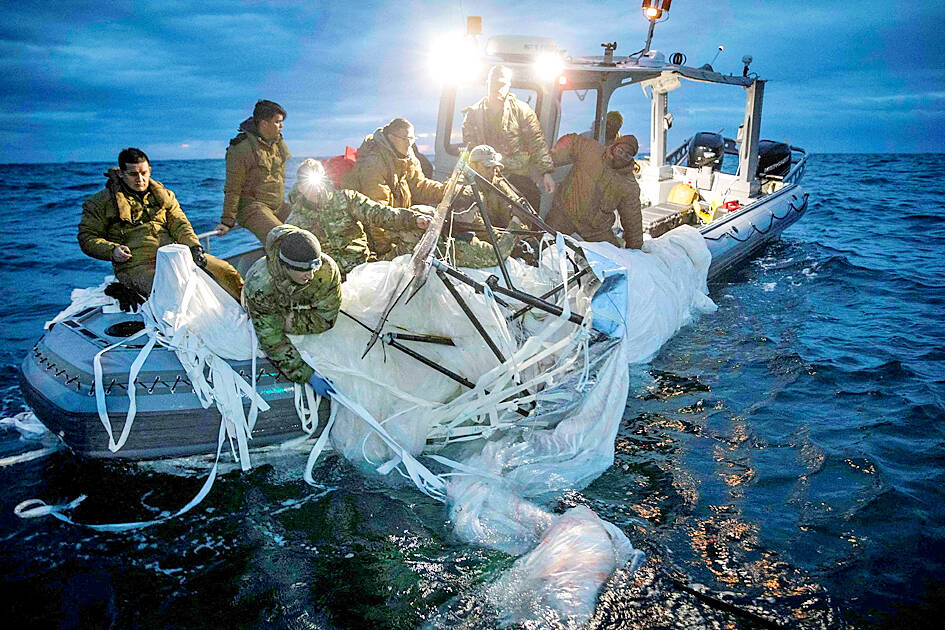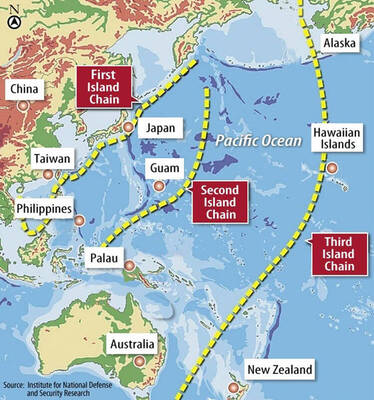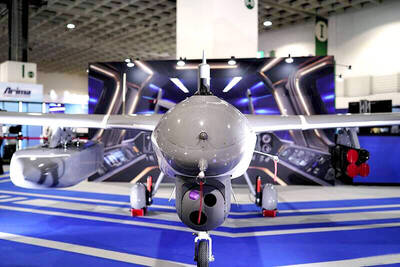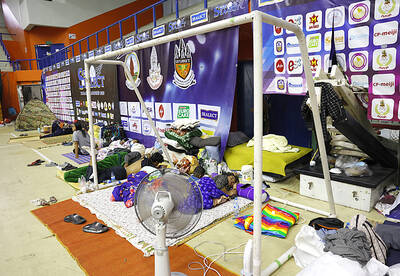The Chinese balloon shot down by the US was equipped to detect and collect intelligence signals as part of a huge, military-linked aerial surveillance program that targeted more than 40 countries, the administration of US President Joe Biden said on Thursday, citing imagery from US military aircraft.
A fleet of balloons operates under the direction of the Chinese People’s Liberation Army and is used specifically for spying, outfitted with high-tech equipment designed to gather sensitive information from targets across the globe, the US said.
Similar balloons have sailed over five continents, the administration said.

Photo: Reuters
A statement from a senior US Department of State official offered the most detail linking China’s military to the balloon that was shot down by the US last weekend over the Atlantic Ocean.
The public details outlining the program’s scope and capabilities were meant to refute China’s denials that the balloon was used for spying, including a claim on Thursday that US accusations about the balloon amount to “information warfare.”
Asked during an interview with the Spanish-language Telemundo Noticias television program whether the balloon was a major security breach, Biden said: “No.”
“The total amount of intelligence gathering that’s going on by every country around the world is overwhelming,” he said. “It’s not a major breach.”
On Capitol Hill, the US House of Representatives voted unanimously to condemn China for a “brazen violation” of US sovereignty and efforts to “deceive the international community through false claims about its intelligence collection campaigns,” voting 419 to zero on the motion.
The US contradicted China’s claims that it was a weather balloon that strayed off course, saying that imagery of the balloon collected by its aircraft as it crossed the country showed that it was “capable of conducting signals intelligence collection” with multiple antennas and other equipment designed to upload sensitive information and solar panels to power them.
Jedidiah Royal, the US assistant defense secretary for the Indo-Pacific region, told a US Senate Appropriations subcommittee that the military has “some very good guesses” about what intelligence China was seeking.
Senior FBI officials who briefed reporters on the condition of anonymity said only a few pieces of the balloon had arrived at the FBI’s Quantico, Virginia, lab for analysis.
So far, investigators have parts of the balloon canopy, wiring, and what one official called “a very small amount of electronics.”
The official said it was “very early for us to assess what the intent was and how the device was operating.”
Two US officials said some balloon debris was intact on the ocean floor and divers had recovered potentially high-value equipment.
Another official said that some of the recovered equipment had English writing on them, but it was not clear if they were from the US or another English-speaking country.
Washington is confident that the manufacturer of the balloon has “a direct relationship with China’s military and is an approved vendor” of its army, the official said.
Washington is reaching out to countries that have also been targeted, the official said.
US Department of State spokesman Ned Price would not identify the other countries targeted, nor did he reveal how the US knows, saying to do so could compromise intelligence sources and methods.
The release of new information appeared part of a coordinated administration response, with multiple officials appearing before congressional committees to face questions about the balloon.
Testifying before the US Senate Foreign Relations Committee, US Deputy Secretary of State Wendy Sherman said officials had taken “all necessary steps to protect sensitive information” and had been able to study and scrutinize the balloon and its equipment.
“We will continue to answer the dangers posed by the PRC [People’s Republic of China] with determination and resolve,” Sherman said. “We will make clear to the PRC that violations of our sovereignty and the sovereignty of other countries are unacceptable.”

The US government has signed defense cooperation agreements with Japan and the Philippines to boost the deterrence capabilities of countries in the first island chain, a report by the National Security Bureau (NSB) showed. The main countries on the first island chain include the two nations and Taiwan. The bureau is to present the report at a meeting of the legislature’s Foreign Affairs and National Defense Committee tomorrow. The US military has deployed Typhon missile systems to Japan’s Yamaguchi Prefecture and Zambales province in the Philippines during their joint military exercises. It has also installed NMESIS anti-ship systems in Japan’s Okinawa

‘WIN-WIN’: The Philippines, and central and eastern European countries are important potential drone cooperation partners, Minister of Foreign Affairs Lin Chia-lung said Minister of Foreign Affairs Lin Chia-lung (林佳龍) in an interview published yesterday confirmed that there are joint ventures between Taiwan and Poland in the drone industry. Lin made the remark in an exclusive interview with the Chinese-language Liberty Times (the Taipei Times’ sister paper). The government-backed Taiwan Excellence Drone International Business Opportunities Alliance and the Polish Chamber of Unmanned Systems on Wednesday last week signed a memorandum of understanding in Poland to develop a “non-China” supply chain for drones and work together on key technologies. Asked if Taiwan prioritized Poland among central and eastern European countries in drone collaboration, Lin

Renewed border fighting between Thailand and Cambodia showed no signs of abating yesterday, leaving hundreds of thousands of displaced people in both countries living in strained conditions as more flooded into temporary shelters. Reporters on the Thai side of the border heard sounds of outgoing, indirect fire yesterday. About 400,000 people have been evacuated from affected areas in Thailand and about 700 schools closed while fighting was ongoing in four border provinces, said Thai Rear Admiral Surasant Kongsiri, a spokesman for the military. Cambodia evacuated more than 127,000 villagers and closed hundreds of schools, the Thai Ministry of Defense said. Thailand’s military announced that

CABINET APPROVAL: People seeking assisted reproduction must be assessed to determine whether they would be adequate parents, the planned changes say Proposed amendments to the Assisted Reproduction Act (人工生殖法) advanced yesterday by the Executive Yuan would grant married lesbian couples and single women access to legal assisted reproductive services. The proposed revisions are “based on the fundamental principle of respecting women’s reproductive autonomy,” Cabinet spokesperson Michelle Lee (李慧芝) quoted Vice Premier Cheng Li-chiun (鄭麗君), who presided over a Cabinet meeting earlier yesterday, as saying at the briefing. The draft amendment would be submitted to the legislature for review. The Ministry of Health and Welfare, which proposed the amendments, said that experts on children’s rights, gender equality, law and medicine attended cross-disciplinary meetings, adding that